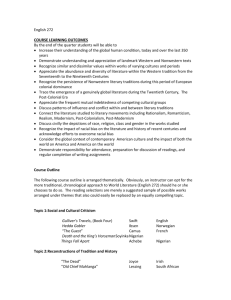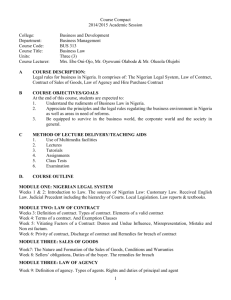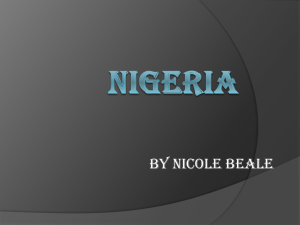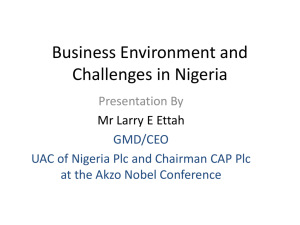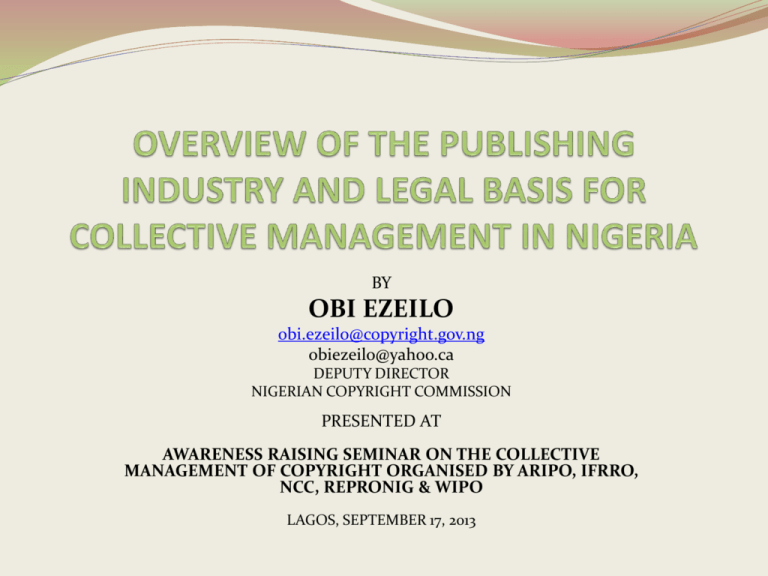
BY
OBI EZEILO
obi.ezeilo@copyright.gov.ng
obiezeilo@yahoo.ca
DEPUTY DIRECTOR
NIGERIAN COPYRIGHT COMMISSION
PRESENTED AT
AWARENESS RAISING SEMINAR ON THE COLLECTIVE
MANAGEMENT OF COPYRIGHT ORGANISED BY ARIPO, IFRRO,
NCC, REPRONIG & WIPO
LAGOS, SEPTEMBER 17, 2013
HISTORY OF THE PUBLISHING INDUSTRY
IN NIGERIA
The very first printing press in Nigeria was established
in Calabar in 1846 by Rev. Hope Waddell of the
Presbyterian church of Scotland Mission.
The press was used to print bible lessons and later
arithmetical books for schools.
In 1854 another missionary based in Abeokuta, Rev
Henry Townsend of the Church Missionary Society
(CMS), established a press.
Five years later (1859), he used it to print the very first
newspaper in Nigeria “Iwe Irohin”. From that effort
grew what we know today as the CMS Press.
HISTORY OF THE PUBLISHING INDUSTRY IN
NIGERIA (CONT.)
The Ibadan University Press was known as the first
scholarly publishing house in West Africa. It was
established in 1952.
Between then and the mid 80’s, many university
presses and publishing houses especially foreign
companies were established in Nigeria, encouraged
mainly by the economic boom of that time.
With the economic decline of late 80’s, the entire
publishing industry started a downwards slide.
Demand for published works reduced and some
foreign publishers left the country.
HISTORY OF THE PUBLISHING INDUSTRY IN
NIGERIA (CONT.)
Some publishing companies began to concentrate on few
academic books where they were sure of the market.
Quality of published works declined. Distribution channels
became distorted.
The dwindling capacity of the big publishers led the
coming into existence of many small publishing companies
Some authors commenced self-publishing or the so-called
‘vanity publishing’.
In some cases, authors entered into partnership with
publishers to partly finance the cost of publication. This
way, the publisher bore only part of the risk in case the
work did not sell.
FEDERAL GOVERNMENT
INTERVENTION IN THE INDUSTRY
Some publishers also resorted to the Print-on-Demand
(POD) system where the books are printed only when they
are demanded for.
The Federal Government made some frantic attempts to
remedy the situation by setting up a number of task forces,
study groups, conferences and committees to save various
facets of book production and distribution especially
academic books to meet the needs of the educational
system, viz;
In 1983, there was the Nigerian National Congress on
Books;
FEDERAL GOVERNMENT INTERVENTION IN
THE INDUSTRY (CONT.)
In 1984, the Task Force on the Scarcity of Books and
Stationery;
In 1987, the Panel on a Book Policy for Nigeria;
In 1989, the ODA/ World Bank Books Sector Study;
In 1990, the National Council on Education
Committee Report on the Rationalization of Textbooks
in Primary and Secondary Schools;
In August-September 1990, the Ministerial Committee
on Provision of Books to Schools and Colleges;
FEDERAL GOVERNMENT INTERVENTION IN
THE INDUSTRY (CONT.)
In August 1993, the Nigerian Educational Research &
Development Council Review Workshop on Preferred
Recommendations for solving the problems of the Nigerian
Book Industry and Formation of Implementation
Strategies;
in April 1994, the National Conference on Book
Development organized by the Nigerian Book Foundation
on the theme "Making Books Readily and Affordable”.
All these efforts and the improved national economy led to
enhanced activities in the publishing industry.
However most of the big publishers still concentrate on
academic books.
THE NIGERIAN COPYRIGHT LAW
The existing copyright legislation in Nigeria is the
Copyright Act Chapter C 28 Laws of the Federation of
Nigeria 2004. It made extensive provision for protection of
copyright works.
Works protected by copyright includes literary works,
musical works, artistic works, cinematograph films, sound
recording and broadcast. There are also provisions for
protection of performer’s right and expression of folklore.
The nature of rights reserved for each class of rights are
similar with a little variation. However, by Section 6 of the
Act, the owner of copyright in a literary or musical work
has the exclusive right to do and authorise the doing of any
of the follow acts:
THE NIGERIAN COPYRIGHT LAW (CONT.)
Reproduce the work
Publish the work
Perform the work in public
Produce, reproduce, perform, or publish any translation
of the work
Make any cinematograph film or a record in respect of
the work
Distribute to the public for commercial purposes copies
of the work by way of rental, lease, hire, loan or similar
arrangement
Broadcast or communicate the work to the public
THE NIGERIAN COPYRIGHT LAW (CONT.)
Make any adaptation of the work
Do in relation to a translation or adaptation of the work any
of the above stated acts
The Act further provides that copyright is infringed by any
person who, without the license or authorisation of the owner
of copyright, does or causes any other person to do an act, the
doing of which is controlled by copyright-Section 15 (1)(a) of the
Act.
The right to reproduce a literary work is therefore reserved
for the owner of the work. However, the reproduction right
reserved is in respect of the whole or a substantial part of
the work either in its original form or in any form
recorgnisably derived from the original. Section 6 (2) of the
Act.
THE NIGERIAN COPYRIGHT LAW (CONT.)
It is then an infringement of the right of the owner to
reproduce the whole or substantial part of his work without
his license or authorisation.
What is whole or substantial has not been defined by
Nigerian courts but the courts will mostly likely be
persuaded by decisions from other commonwealth nations
in this area.
The courts will be inclined to accept the English law
principle that "what is worth copying is prima facie worth
protecting". The question of what would amount to a
substantial part of a work is one of fact and degree.
THE NIGERIAN COPYRIGHT LAW (CONT.)
As declared by Lord Reid in Ladbroke (Football) Ltd. v.
William Hill (Football) Ltd., "the question whether the
defendant has copied a substantial part of a work
depends much more on the quality than the quantity
of what he has taken."
Therefore where students or lecturers decide to
photocopy portions of a textbook or journal which
they deem so important to photocopy and keep, it may
be difficult to say that those portions photocopied are
not substantial part of the book.
THE NIGERIAN COPYRIGHT LAW (CONT.)
The law went further to define reproduction to mean the
making of one or more copies of a literary, musical or
artistic work, cinematograph film or sound recording.
Section 51 of the Act.
It is instructive to note that the Nigerian Copyright Act
does not make specific reference to photocopying or
reprography but to the more generic incidence of
reproduction which is all inclusive.
Although photocopying often includes literary, artistic and
musical works, there is very little use of sheet music in
Nigeria. The bulk of the photocopying that goes on is
therefore in literary works, particularly books and artistic
works either as illustrations, diagrams or photographs.
COLLECTIVE MANAGEMENT OF
COPYRIGHT IN NIGERIA
The Nigerian Copyright Act not only provided adequately
for the rights in literary works but also anticipated the
consequences of infringement. It recognizes that it would
be impractical for every prospective user to obtain license
from the respective right owners for every intended use of
every work.
It provides that a collecting society may be formed in
respect of any one or more rights of copyright owners for
the benefit of such owners and the society may apply to the
Nigerian Copyright Commission( NCC) for approval to
operate as a collecting society- Section 39 (1).
NCC may approve a society to operate as a collecting
society if it is satisfied that the society meets certain listed
pre-conditions- Section 39 (2).
COLLECTIVE MANAGEMENT OF COPYRIGHT
IN NIGERIA (CONT.)
NCC may make regulations guiding the operation of
collecting societies – Section 39 (2)(d).
It is a crime punishable upon conviction by a term of
imprisonment for any organisation, person or group of
persons to purport to perform the duties of a society
without the approval of NCC - Section 39 (4)(5) & (6).
The Commission has made the Copyright (Collective
Management Organisations) Regulations 2007.
NCC POLICY ON REGULATION OF CMOs
To encourage the establishment of strong and credible
national CMOs that will reflect the aspirations and
expectations of Nigerian authors;
To encourage, as far as possible, the formation of CMOs for
different categories of copyright works or class of rights;
To provide technical support for effective management of
rights by approved CMOs;
To engender transparency and accountability in the
management of affairs of CMOs;
To ensure a proper balancing of the interest of authors of
copyright works in relation to users of copyright works; and
To ensure a conducive and rancour-free licensing
environment for approved CMOs.
REQUIREMENTS FOR MANAGEMENT
AND MEMBERSHIP STRUCTURE
• Organs of a CMO must include General Assembly of all
members and Governing Board/Council; (Reg.1 (3)(b));
• The CEO, who shall not be a member of the organization,
should be a person knowledgeable on copyright;
• The internal rules of the organization (articles of
association) must provide for representation of the NCC at
meetings of the organization;
• Only a member of the CMO can be appointed as a
Chairman of the Governing Board and the Governing
Board and Management shall be Citizens of Nigeria and
ordinarily resident in Nigeria;
REQUIREMENTS FOR MANAGEMENT AND
MEMBERSHIP STRUCTURE (CONT.)
• The Governing Board shall as far as possible reflect the
different categories of right owners in the CMO.
• Membership of the organization must be open to all right
owners of the category of rights for which CMO is seeking
license to operate;
• The CMO should not impose as requirement of
enrollment, that a member should constitute the CMO as
his sole agent or agent for other purposes;
• Provision may be made for collective membership or
membership through an association but each member shall
be entitled to one vote with similar rights and privileges;
PUBLISHING INDUSTRY AND
COLLECTIVE MANAGEMENT
• The basis for the collective management of rights is the
existence in a right owners a right of an exclusive nature
prohibiting third party dealing therein without prior
authorization.
• The Copyright Act however confers ownership of copyright
in a literary work on the author and not the publisher.
Unlike what obtains in some other jurisdictions, copyright
protection for literary works does not extend to the
typographical arrangement of the text or material.
• There is much persuasion in the argument that publishers
should be granted a separate right in typographical
arrangements of a work in a manner similar to the rights
granted to recording companies in their sound recordings
but this has not yet been incorporated in Nigerian law.
PUBLISHING INDUSTRY AND
COLLECTIVE MANAGEMENT (CONT.)
The publishing companies therefore derive their right
to literary works and to collective management of
literary work from the contracts they signed with
authors of these works.
The only Collective Management Organisation
approved by NCC to administer literary rights in
Nigeria is the Reproduction Rights Society of Nigeria
(REPRONIG).
EXCEPTIONS TO THE RIGHT OF THE
COPYRIGHT OWNER
The second schedule of the Copyright Act provides
some exceptions to the rights reserved exclusively for
the owner of a copyright work including the right of
reproduction of the owner of a literary work.
These exceptions include some limited use of works by
educational institutions, the government, National
Archives, media organisations, public library, the
museum or reproduction of a published work in braille
for the exclusive use of the blind.
EXCEPTIONS TO THE RIGHT OF THE
COPYRIGHT OWNER (CONT.)
By far the most challenging exception is the provision that
‘the right conferred in respect of any work does not include
the right to control the doing of any of the acts mentioned
by way of fair dealing for purposes of research, private use,
criticism or review or the reporting of current events…’
This is essentially a codification of a long standing
common law principle permitting the "fair use" of a portion
of a work either for purposes of illustration, review or
criticism, so long as the quantity and value of the portion
taken was not substantial.
it is difficult to define in precise terms what would
constitute "fair dealing". The facts of each case would
therefore have to be approached separately and with
cautions.
EXCEPTIONS TO THE RIGHT OF THE
COPYRIGHT OWNER (CONT.)
As formulated by Justice Story of the US, ‘the question . . .
is whether [the act complained of] is a justifiable use of the
original materials, such as the law recognizes as no
infringement of the copyright. . . . [We] must often, in
deciding questions of this sort, look to the nature and
object of the selection made, the quantity and value of the
materials used, and the degree in which the use may
prejudice the sale, or diminish the profits, or supersede the
objects of the original work’.
Apart from the requirement that the use of the work must
constitute fair dealing, it must also be for the purpose of
research, private use, criticism and review or for reporting
of current events. This provision makes it even more
difficult for a user to take benefit of this exception.
EXCEPTIONS TO THE RIGHT OF THE
COPYRIGHT OWNER (CONT.)
It is likely that the courts will interpret this provision very
strictly, the general understanding being that these kinds of
exceptions should apply in "special cases which do not conflict
with a normal exploitation of the work and do not unreasonably
prejudice the legitimate interests of the right holder’’.
In the final analysis, any reproduction that could be seen to
affect the economic interest of the author will most likely not be
covered by the fair dealing exception.
The issue of fair dealing is certainly formidable but not
insurmountable. REPRONIG and other interested parties should
continue to negotiate and agree on the boundaries of the
protected rights. Unfortunately, none of the exceptions provided
in schedule 2 of the Act has been tested in our courts. In any
event, it would be in the interest of both owners and users of
works that the areas of conflict are resolved out of court.
PAYMENT FOR REPRODUCTION OF
LITERARY WORKS
Photocopying remains the most visible violation of
copyright in literary works. While one would have been
pleased to note that this once revolutionary technology is
gradually phasing out, more intense challenges and wider
opportunities are even presented by the emerging
electronic and Internet based technologies of today.
All business outfits which engage in large scale
photocopying and other forms of reproduction including
reproduction in the digital environment ought to obtain
licenses and pay royalties for such reproduction to
REPRONIG.
PAYMENT FOR REPRODUCTION OF
LITERARY WORKS (CONT.)
Copyright infringement is a species of tort and as is the
case with other torts, any person that is found to have
collaborated with the primary defendant in the
commission of the infringement would be liable as a joint
tortfeasor.
Similarly, an employer may be held vicariously liable for a
copyright infringement committed by its employee acting
in the course of his duty. In such cases, it is no defence that
the employee may have been given a general warning or
prohibition against the doing of acts that might amount to
an infringement.
Consequently, educational institutions are liable for the
reproduction of works carried out by its members of staff
and students in its environment.
PAYMENT FOR REPRODUCTION OF
LITERARY WORKS (CONT.)
Educational institutions are secondary infringers. They
would be directly liable either for doing or authorizing
the doing of the infringing act or vicariously for the
actions of its teachers and students. It is therefore
important that these institutions negotiate and obtain
licenses for works used within their institutions.
CONCLUSION
The history of copyright through the last four
Centuries has been characterized by the challenges of
emerging technologies and the conflict between
protection and access.
While photocopying and other forms reproduction
grant more access to users of literary, musical and
artistic works, it is also important that these usages are
paid for because as they say, ‘a labourer is entitled to
his wage’.
END OF PRESENTATION
THANK YOU

